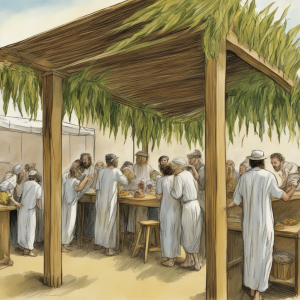“Sukkot: Unveiling the Divine Blueprint from Yeshua’s Birth to His Prophesied Second Coming”


Introduction
Sukkot, commonly known as the Feast of Tabernacles, is one of the most celebrated festivals in the Jewish calendar. Traditionally, it serves as a remembrance of the Israelites’ 40-year journey in the wilderness, living in temporary shelters, or sukkot. It is also a harvest festival, marking a time of joy and bounty. But could there be more to this age-old festival? For believers in Yeshua (Jesus), Sukkot is a multifaceted tapestry woven through time—from the anticipated Messiah’s birth to His prophesied second coming. Let’s delve into this rich narrative.
The Historical Context: Sukkot in the Old Testament
The roots of Sukkot are firmly planted in the Torah. In Leviticus 23:34-43, Yehovah commands the Israelites to observe this festival as a seven-day period of rest and rejoicing, during which they should dwell in temporary shelters. This commemoration serves as a constant reminder of Yehovah’s provision and protection as He led the Israelites out of Egypt and through the wilderness.
Sukkot was not just an Israelite affair; it was universal in its scope. According to Zechariah 14:16, “Then the survivors from all the nations that have attacked Jerusalem will go up year after year to worship the King, Yehovah Almighty, and to celebrate the Festival of Tabernacles.” This scripture foreshadows a time when all nations will recognize Yehovah and participate in this joyous festival.
Yeshua’s Birth: God “Tabernacling” Among Us
One of the most compelling reasons to connect Yeshua’s birth to Sukkot is found in the Gospel of John: “And the Word became flesh and dwelt among us, and we have seen His glory, glory as of the only Son from the Father, full of grace and truth” (John 1:14). The term “dwelt” here is derived from the Greek word “skēnoō,” which can be translated as “to tabernacle.” This has led many to believe that Yeshua, the living Word, chose the Feast of Tabernacles as the time to make His dwelling among humanity.
Additionally, Luke 2:8 mentions shepherds keeping watch over their flocks by night, suggesting that Yeshua’s birth likely occurred during a warmer season. Shepherds in Israel would not typically be in the fields during the cold winter months. This supports the theory that Yeshua may have been born around the time of Sukkot, which falls in the autumn.
The Nativity: A Temporary Shelter?
Let’s consider the birthplace of Yeshua—a manger. The humble setting could metaphorically serve as a temporary “sukkah,” signifying the impermanence and humility associated with Sukkot. In contrast to the idea of a king born in a palace, Yeshua’s nativity setting aligns well with the themes of Sukkot—God dwelling among His people in the humblest of circumstances.
Prophetic Significance: The Second Coming
The Feast of Tabernacles not only points backward to the Israelites’ journey and potentially to Yeshua’s birth, but it also casts our gaze forward to prophetic events. As previously mentioned, Zechariah talks about a time when all nations will celebrate Sukkot in Jerusalem. This universal acknowledgment of Yehovah sets the stage for the Messianic Age, which many interpret as Yeshua’s millennial reign.
Revelation 21:3 echoes this sentiment: “And I heard a loud voice from the throne saying, ‘Behold, the dwelling place of God is with man. He will dwell with them, and they will be His people, and God Himself will be with them as their God.'” Just as Sukkot involves dwelling in temporary shelters, the end times point to a more permanent dwelling place with Yehovah, fulfilling the ultimate promise of His presence among us.
Sukkot in Yeshua’s Ministry
It’s worth noting that Yeshua observed Sukkot during His earthly ministry. In John 7, we find Him going up to Jerusalem for the festival. He taught in the temple, offering living water (John 7:37-38), a fitting metaphor given the water-libation ceremony that was part of the traditional Sukkot observance. This links back to the notion of Yeshua as the source of “living water,” fulfilling the physical and spiritual needs of His people.
A Universal Invitation
Sukkot serves as a poignant reminder that Yehovah’s plan is not just for the Israelites but for all nations. Isaiah 56:7 states, “These I will bring to My holy mountain, and make them joyful in My house of prayer; their burnt offerings and their sacrifices will be accepted on My altar; for My house shall be called a house of prayer for all peoples.” Sukkot is a time when this vision inches closer to reality, reminding us of a future where Yehovah’s love and law are recognized universally.
Conclusion
Sukkot is much more than an ancient Jewish festival; for believers in Yeshua, it serves as a guidepost on the journey of faith. Through its rich traditions and scriptural foundations, Sukkot allows us to explore the depths of Yehovah’s past provisions, understand the significance of Yeshua’s life, and anticipate the glorious future that awaits us. It is a timeless connection between Yehovah and His people, a cycle of divine interaction that began in the wilderness, manifested in the birth and life of Yeshua, and will culminate in His glorious second coming.
By understanding and participating in this divine festival, we not only honor the traditions handed down through generations but also enrich our spiritual lives, fostering a closer relationship with Yehovah and a deeper understanding of His ultimate plan for humanity.

